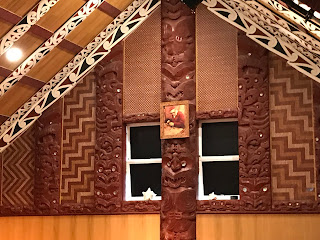Tauranga, Geothermal Rotorua, and Maori Culture
A very interesting thing has happened to us since being on this ship sailing the vast ocean waters of the Pacific. Without the responsibilities of everyday life and without the obstruction of neighboring homes and cities, we have become mesmerized by the compositions formed daily by sun, clouds, water, and islands. This morning on the sail in to Tauranga, I caught this shot and want to share it.
 The flat map at left doesn't show it, but at the very point of the peninsula just below the gray dot, is the lava dome pictured below. The photo is taken at sail out, which is why the tug is pulling, but it's our favorite shot of Mt. Maunganui at the entrance to the harbor of Tauranga.
The flat map at left doesn't show it, but at the very point of the peninsula just below the gray dot, is the lava dome pictured below. The photo is taken at sail out, which is why the tug is pulling, but it's our favorite shot of Mt. Maunganui at the entrance to the harbor of Tauranga. 
Part of the Bay of Plenty region, this harbor is the largest export port and 3rd largest overall in New Zealand. It is the 5th largest city in the country with a population of 140,000.
 The town of Te Puke (pronounced poo-kah) is at the heart of the kiwifruit region. On my excursion, we drove past acres of kiwifruit (Chinese gooseberry) which grow on vines surrounded by very tall rows of windbreak vegetation. Apparently, in spring (Sept., Oct., and Nov.), when the vines are in bloom, there are frequent damaging winds. The fruit is picked by hand during April and May and ripens slowly over 8 weeks of refrigeration. We were told that kiwifruit have more vitamin C than oranges.
The town of Te Puke (pronounced poo-kah) is at the heart of the kiwifruit region. On my excursion, we drove past acres of kiwifruit (Chinese gooseberry) which grow on vines surrounded by very tall rows of windbreak vegetation. Apparently, in spring (Sept., Oct., and Nov.), when the vines are in bloom, there are frequent damaging winds. The fruit is picked by hand during April and May and ripens slowly over 8 weeks of refrigeration. We were told that kiwifruit have more vitamin C than oranges.
We also drove through a large forested area where the Pinas Radiata, or Monterrey Pine seedlings are planted. These trees mature in 15-20 years, thus valuable for lumber and pulp. From there, we drove past Lake Rotorua, a volcanic lake, to the town of Rotorua. The Maori have lived near the geothermal activity connected to the lake for many years. Te Puia (Our Heritage) a Maori cultural center and school is the most recent iteration of an arts and crafts school established in 1926 to preserve their traditions. It was located near the geothermal region to tap into the tourist base who visit.
 When we arrived inside the compound, we were welcomed into the Marae, or communal meeting house, by an elaborate ceremony which ended in the traditional touching of noses.
When we arrived inside the compound, we were welcomed into the Marae, or communal meeting house, by an elaborate ceremony which ended in the traditional touching of noses.  We sat to watch a performance of singing and dancing, or Kapa haka, very similar to the one we had enjoyed on the Viking Sun on our first night in Auckland. The women use the Poi balls, swinging them and bouncing them off hands, arms and shoulders. The group also used short sticks in a dance similar to one I learned in elementary school.
We sat to watch a performance of singing and dancing, or Kapa haka, very similar to the one we had enjoyed on the Viking Sun on our first night in Auckland. The women use the Poi balls, swinging them and bouncing them off hands, arms and shoulders. The group also used short sticks in a dance similar to one I learned in elementary school.  It was fun to see some of the same designs on the walls and ceiling that were on the fabric our crazy quilting group had bought in Auckland.
It was fun to see some of the same designs on the walls and ceiling that were on the fabric our crazy quilting group had bought in Auckland. David went on a different excursion driving around "Scenic Tauranga", but both of us saw Pouwhenua, or land posts, which can commemorate warriors, or reflect the relationship between the people and the land.
 The Rotorua geothermal area that I saw, was much smaller that I had imagined, but of special note was the Pohuta geyser which, although much smaller than Old Faithful, goes off up to 20 times per day and can reach heights of up to 100 feet. We also saw mud pots which were reported to have many health benefits.
The Rotorua geothermal area that I saw, was much smaller that I had imagined, but of special note was the Pohuta geyser which, although much smaller than Old Faithful, goes off up to 20 times per day and can reach heights of up to 100 feet. We also saw mud pots which were reported to have many health benefits.
Now, on to Napier, a city completely destroyed in a 1931 earthquake and rebuilt in the Art Deco style. New Zealand, so far, is truly as beautiful as they say.




Comments
Post a Comment